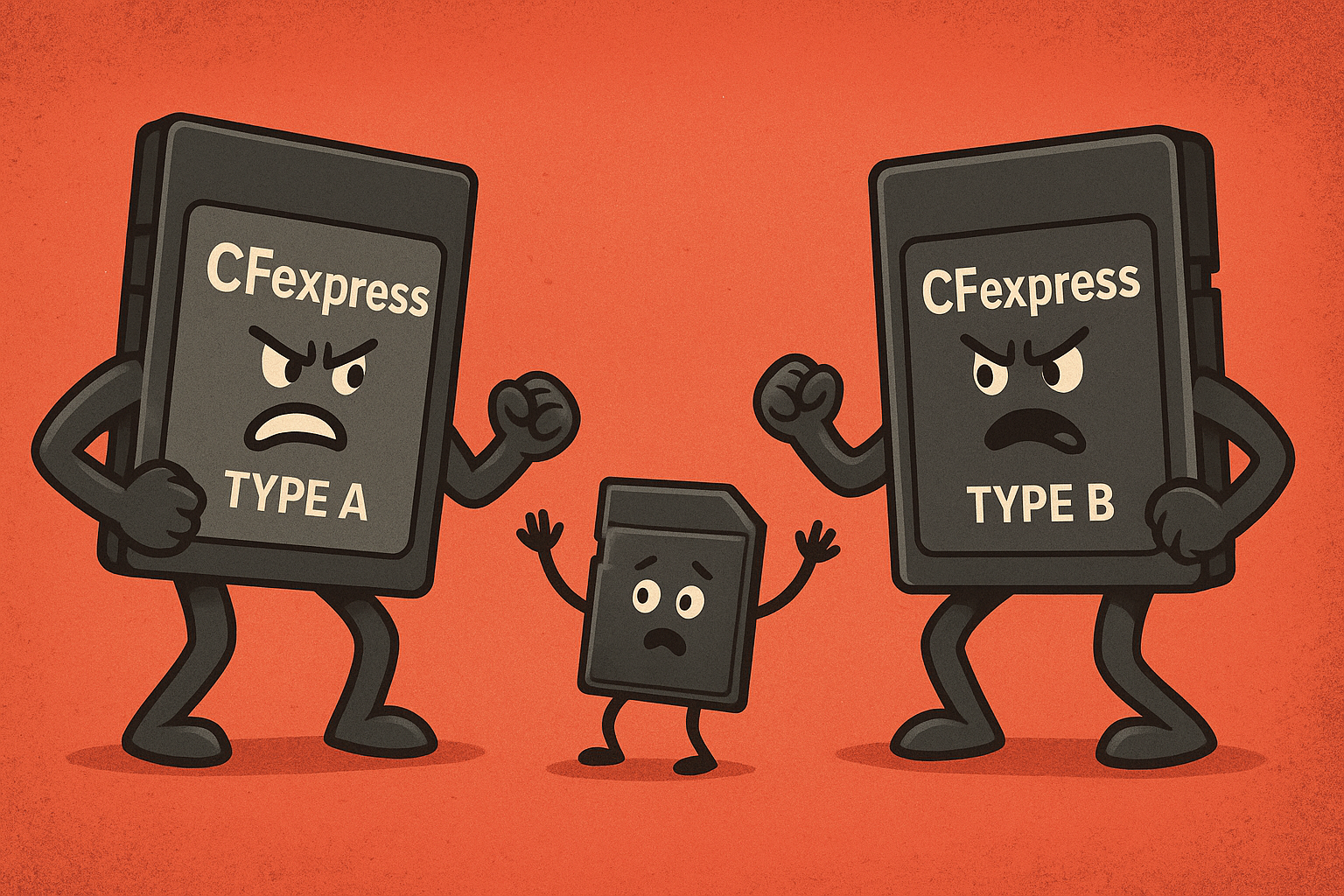Difference Between CFexpress Type A and CFexpress Type B
If you’ve shopped for new memory cards lately, you’ve probably run into the terms **CFexpress Type A** and **CFexpress Type B**. For many photographers and videographers, especially those moving into higher-end mirrorless systems, these new cards can be confusing. Why are there different “types”? How do they compare to the SD cards most of us are used to? And which one is right for your workflow?
This guide breaks down everything you need to know—whether you’re a beginner trying to future-proof your gear or a professional managing 8K RAW workflows.
A Quick Look at CFexpress
CFexpress is a relatively new memory card standard developed to handle the massive data rates of modern cameras. Unlike older standards like SD, CFexpress cards use **PCIe (Peripheral Component Interconnect Express)** interfaces—the same high-speed lanes that connect solid-state drives (SSDs) inside computers. This makes them much faster and more reliable for today’s demands, especially continuous burst shooting and ultra-high-resolution video.
But here’s the wrinkle: CFexpress comes in different **form factors**, and that’s where Type A and Type B come in.
CFexpress Type A
Physical Design
Size: 20mm × 28mm × 2.8mm
Roughly the size of an SD card, but slightly thicker.
Small enough to fit into compact camera bodies.
Performance Interface: PCIe 3.0 with 1 lane
Maximum theoretical speed:** \~1,000 MB/s (1 GB/s)
Real-world speeds are usually in the **700–800 MB/s range
Who Uses It?
CFexpress Type A is still relatively rare. Currently, Sony is the main camera manufacturer using this format. You’ll find it in cameras like the **Sony A7S III, A1, A7 IV, and FX3**. Why Sony? The smaller size of Type A allows these cameras to maintain a compact form factor while still offering a big jump over SD card speeds.
Pros and Cons
✅ Compact size fits smaller bodies
✅ Faster than SD cards
❌ More expensive (fewer manufacturers, lower supply)
❌ Not as fast as Type B
CFexpress Type B
Physical Design
Size: 38.5mm × 29.8mm × 3.8mm
Similar in size to the older **XQD cards** (in fact, some cameras that supported XQD can now support CFexpress Type B via firmware).
Larger and thicker than both SD and Type A cards.
Performance Interface: PCIe 3.0 with 2 lanes
Maximum theoretical speed:** \~2,000 MB/s (2 GB/s)
Real-world speeds often hover between **1,400–1,700 MB/s** depending on the brand.
Who Uses It?
CFexpress Type B is the most common and widely adopted of the two formats. Major brands like **Canon, Nikon, Panasonic, RED, and Blackmagic** have embraced it. Cameras like the **Canon EOS R5MKII, Nikon Z9, Z8, and Panasonic S1RII all rely on Type B.
Pros and Cons
✅ Much faster than Type A
✅ Widespread adoption and broader ecosystem
✅ Great for 8K RAW, high-bitrate video, long bursts
❌ Larger card size
❌ Can generate more heat in long shooting sessions
CFexpress vs. SD Cards
For years, SD cards have been the workhorse of photography. UHS-I and UHS-II cards are everywhere—affordable, compact, and compatible with most cameras. But they’re hitting their ceiling.
SD Card Performance Today
UHS-I SD cards: Up to \~104 MB/s
UHS-II SD cards: Up to \~312 MB/s
UHS-III and SD Express (PCIe based): Announced, but rarely seen in actual products yet. Even the fastest UHS-II SD cards struggle when compared to CFexpress. For context:
Shooting long bursts with a 45MP or 61MP camera will quickly fill the SD card buffer.
Recording 8K or RAW video is often impossible or severely limited on SD.
How they compare
Which One Should You Choose? If you are a beginner and your camera supports SD cards and you’re not shooting high-speed bursts or 8K video, a UHS-II SD card is still fine—and far cheaper. But if your camera offers a dual-slot system (SD + CFexpress), investing in one CFexpress card is smart for future-proofing and demanding shoots.
If You’re an Advanced Photographer or Videographer-
For Sony shooters: You’ll need CFexpress Type A if you want the fastest write speeds. Consider dual-slot cards (many Sony cameras share slots for SD and Type A) for flexibility.
For Canon/Nikon/Panasonic/RED: Type B is the way to go. These cards unlock continuous high-burst photography, 4K/6K/8K RAW, and long-form recording without bottlenecks.
CFexpress is the future of high-performance storage in cameras. The distinction between Type A and Type B mainly comes down to size and speed: Type A = Smaller, slower, Sony-focused. Type B = Larger, faster, industry-wide. Compared to SD cards, both formats are a massive leap forward. If you’re working with today’s high-resolution stills or demanding video codecs, CFexpress is more than just a luxury—it’s a necessity. That said, SD cards aren’t disappearing overnight. For casual shooters, they’re still reliable, affordable, and everywhere. But as more cameras push the limits, expect CFexpress to become the new normal—whether you’re team Type A or Type B.

